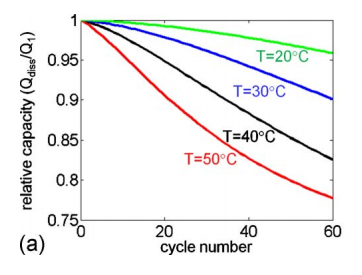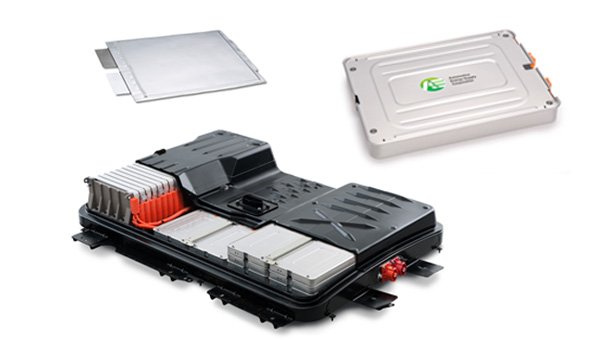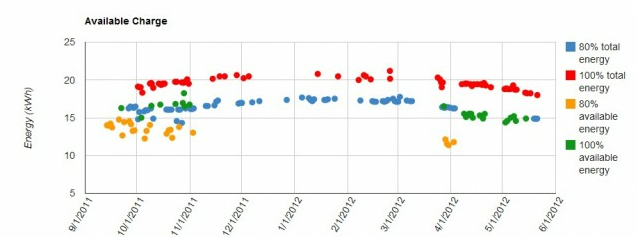What does temperature have to do with it?
Pretty much everything, it seems.
Now that we’ve waded through the second 25 pages of posts and visited countless other articles, blogs and images from said posts, the fact that all of our early battery capacity loss LEAFs are in Phoenix, or at least in Arizona, is no coincidence.
It took only 11 days for the first 25 pages of posts to be created regarding this topic. Two weeks covered the next 25 pages, taking us up to June 4. We had two more LEAF owners declare battery capacity loss – both living in Arizona – bringing our vehicle count to seven thus far. All seven vehicles were in service from June through September of 2011. Why is this important? Because for three months straight from June 10, 2011 through September 10, 2011, the high temperature in Phoenix was over 100 degrees every single day. The highest high was 118 degrees on July 2, and there were 34 days at or over 110 degrees with one consecutive eight day stretch with highs of 110 degrees or higher. The lows were typically in the 80 to 90 degree range during this time, with drops into the high 70 degree range near the beginning and end of this time frame.
One of the reasons that we think temperature and not mileage is the deciding factor comes from a LEAF owner in Washington state. In his first year of ownership, he has covered almost 38,000 miles (which is likely considerably higher by now), with no battery capacity loss. There are also reports of other LEAF drivers having driven 22,200 miles in one instance and 20,500 miles in another instance with no battery capacity loss. There are several others with an accumulated 18,000 miles or more that have experienced no loss in other parts of the country that have owned their LEAFs for roughly the same amount of time.
Reviewing some of the reference items in the various posts has us more convinced of the impact of heat on battery life. We will actually start with an interesting bit from one of the owners that has already lost a battery capacity segment. Here is a graph plotted from his car that shows the relationship of capacity over time:
This plot was achieved using an aftermarket tool developed by a LEAF owner that measures the amount of electricity actually entering the battery pack. The red dots in the above graph represent the energy stored after a 100% charging session. From October 2011 through February 2012 it appears that the battery capacity actually increased as the temperature cooled in Arizona and it started falling again as the temperature started moving up in the spring. What we don’t know is this – is this a result of the battery management system (BMS) controlling the amount of energy sent to the battery, or is it actually a change in the internal composition of the battery? Perhaps some combination of the two.
Another interesting graph made its way into the discussion as the impact of temperature on battery capacity loss became more prevalent:
 As can be seen in this graph, the impact of the temperature on battery capacity is significant. This evaluation was not performed on a Nissan LEAF battery, but it was performed on similar Lithium ion battery chemistry. There is, though, one thing worth noting in the observation of this graph. At 20 degrees Celsius (68 degrees Fahrenheit) the green line shows the slowest rate of capacity loss. At 50 degrees Celsius (122 degrees Fahrenheit) the red line shows a greater loss, but a slowing rate of decrease in capacity with an increase in cycles. Without seeing this experiment run over a greater number of cycles, it is difficult to predict, but one can extrapolate that the extremely high temperature data set may continue to slow over some period of an increasing number of cycles. It may be wishful thinking on our part, but we see each of these slopes as the equivalent of the right side of a typical bell curve, tapering off quickly from the peak (or slowly, in the case of the 20 degree Celsius curve) with the curve flattening out the further from the peak that it gets. Certainly we would like to see this experiment repeated with a much larger cycle parameter involved. The number of cycles indicated in the above graph is not the physical number of times that a LEAF battery would be plugged in to a charging dock, but the equivalent of full charge to full discharge per cycle.
As can be seen in this graph, the impact of the temperature on battery capacity is significant. This evaluation was not performed on a Nissan LEAF battery, but it was performed on similar Lithium ion battery chemistry. There is, though, one thing worth noting in the observation of this graph. At 20 degrees Celsius (68 degrees Fahrenheit) the green line shows the slowest rate of capacity loss. At 50 degrees Celsius (122 degrees Fahrenheit) the red line shows a greater loss, but a slowing rate of decrease in capacity with an increase in cycles. Without seeing this experiment run over a greater number of cycles, it is difficult to predict, but one can extrapolate that the extremely high temperature data set may continue to slow over some period of an increasing number of cycles. It may be wishful thinking on our part, but we see each of these slopes as the equivalent of the right side of a typical bell curve, tapering off quickly from the peak (or slowly, in the case of the 20 degree Celsius curve) with the curve flattening out the further from the peak that it gets. Certainly we would like to see this experiment repeated with a much larger cycle parameter involved. The number of cycles indicated in the above graph is not the physical number of times that a LEAF battery would be plugged in to a charging dock, but the equivalent of full charge to full discharge per cycle.
As we have seen thus far, battery capacity loss in the LEAF does not seem to be a factor of mileage, but rather one of locale. There is much yet to be learned though, as this topic has now reached almost 200 pages in length and we still have 150 pages to go. As they say, stay tuned.



As you mentioned in your reference to TickTock’s charging records, there is evidence, that some limitation on maximum charge may be set by the LEAF’s battery management system. So it is possible, that what the capacity bar display, as well the GID and SOC reports from aftermarket capacity monitoring devices are showing, in part, is that the BMS is limiting the charge level, to a lower percentage of the total battery capacity.
The LEAFs with lost bars may not have “lost” the entire amount of capacity indicated. The bar display may be indicating restrictions, on the maximum percentage of the 24 kWh battery pack, that the LEAF BMS makes available, at “100%” charge. So TickTock’s report may indicate that much of the “capacity loss”suffers by his and other bar-loss LEAFs is actually BMS operation. And also remember that the TickTock’s record of increasing capacity is concurrent with cooler ambient temperatures last fall, when you probably should expect capacity of the (unheated) LEAF battery, to decline significantly.
The implication, of course, is that the Capacity-bar-loss LEAFs may regain “capacity” in the future, as TickTock’s seems to have done last fall.
Hopefully many LEAF owners are now making the same observations TickTock has. We may see kWh charges begin to climb, somewhere in the next two months, the remaining time gap, in TickTock’s annual record
The LEAF allows the Driver to use a very high percentage of the total battery capacity, generally believed to be about 93-94%, but based, as far as I know , on observations only of cool-climate LEAF Battery packs.
It would be poor planning, in my opinion, if Nissan has not designed the BMS to be adaptive, and limit charging under high-heat conditions, to help “fool-proof” the maximum charge level for hot-climate regions, where high SOC levels are believed to be most likely to lead to rapid capacity degradation.
Remember that some other EVs such as the Volt, that have active thermal management, allow drivers much less access to their battery’s total capacity, at all times.
Have fun wading through this overly long thread, Ernie. I’m Looking forward to your further comments.
Hope I’m not the bearer of bad news, when I tell you the near-hysteria on MNL, has led to many other threads, on the same topic.
Ed
Another interesting analysis Ernie! Is there any data for LEAFs in AZ (or other very hot locations) which are of similar age and mileage, but which have *not* seen at least one bar capacity loss? In other words, if your theory is correct, then every LEAF in the same general location with the same general mileage should be seeing the same capacity loss. If that’s not the case, then there’s more going on here. The reason I bring this up is you say the total is up to seven. That seems rather low to me. There must be hundreds of LEAFs in AZ by now.
I think the best estimate for Arizona is about 400 LEAFs, but its unknown what percentage, between ~ 10% and ~100%, have lost bars. However, I haven’t seen any AZ LEAFs reporting no bar loss on MNL, recently.
See the wiki for more recent reports of bar loss.
http://mynissanleaf.com/wiki/index.php?title=Real_World_Battery_Capacity_Loss
~10% to ~100% is a rather large spread. The page you pointed me to listed some LEAFs at the bottom with, what they said was, no capacity loss. Also, it appears that AZ isn’t the only state where this is occurring, I saw TX and CA listed as well.
So is one bar 10% of the pack?
Pingback: Nissan LEAF battery capacity loss – Third in a series — Living LEAF
Pingback: Nissan LEAF battery capacity loss – last in a series — Living LEAF